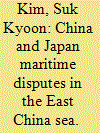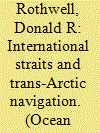| Srl | Item |
| 1 |
ID:
114645


|
|
|
|
|
| Publication |
2012.
|
| Summary/Abstract |
This article examines recent developments in the East China Sea maritime disputes, focusing primarily on the Principled Consensus agreed on by China and Japan for the joint development of energy resources. The article also provides a perspective on the East China Sea maritime disputes between the two countries within the context of international relations.
|
|
|
|
|
|
|
|
|
|
|
|
|
|
|
|
| 2 |
ID:
114643


|
|
|
|
|
| Publication |
2012.
|
| Summary/Abstract |
The Arctic Ocean is increasingly becoming accessible to international shipping as a result of the reduction in Arctic sea ice. Commercial shipping may seek to transit the Arctic Ocean from either the Pacific or Atlantic Ocean and, as a result, the legal regime of straits has significance for trans-Arctic navigation. In this article, current developments in Arctic shipping are assessed and consideration is given to certain Arctic straits that could prove to be pivotal in future Arctic navigation and shipping. These straits include the Bering Strait, Nares Strait, Davis Strait, Fram Strait, and Denmark Strait.
|
|
|
|
|
|
|
|
|
|
|
|
|
|
|
|
| 3 |
ID:
114642


|
|
|
|
|
| Publication |
2012.
|
| Summary/Abstract |
Transboundary marine protected areas have been proposed in East Africa to tackle threats to marine biodiversity, meet international MPA targets, promote tourism, and contribute to poverty reduction. This article examines what may drive, facilitate, or constrain states in creating a regime for transboundary MPAs. In East Africa, a regime between Mozambique and Tanzania is not yet formed and may be indefinitely delayed due to oil prospecting and exploration. There is, however, a well-developed regime between Mozambique and South Africa that has resulted in the two adjoining MPAs being declared the first transboundary MPA on the continent.
|
|
|
|
|
|
|
|
|
|
|
|
|
|
|
|
| 4 |
ID:
114644


|
|
|
|
|
| Publication |
2012.
|
| Summary/Abstract |
This article identifies potential areas of cooperation in the South China Sea, particularly on ocean-related matters. Several regional mechanisms related to marine and coastal environments have been established and, to an extent, have achieved their goals. Nevertheless, some improvements to existing mechanisms are highly desirable. Recommended is a regional mechanism that involves all bordering parties; limits its geographic scope to the South China Sea; is initiated and operates without the assistance of global organizations; is embodied in a legally binding instrument; and broadens the scope of cooperation to include marine living resources, maritime safety, and maritime security.
|
|
|
|
|
|
|
|
|
|
|
|
|
|
|
|
| 5 |
ID:
114641


|
|
|
|
|
| Publication |
2012.
|
| Summary/Abstract |
Submarine communications cables laid on the seabed of the ocean are the foundation of the world's international telecommunications network. International law, in particular, the law of the sea, has recognized the freedom to lay submarine cables and perform associated operations and has placed certain obligations on states related to the protection of submarine cables. This article examines the international law with respect to submarine cables and discusses the various problems with both the law and state practice on submarine cables. It argues that these problems are illustrations of the traditional challenges that face the law of the sea; that is, the balancing and accommodation of competing uses of ocean space. It concludes that an important step toward resolving these problems is enhanced consultation and cooperation between cable companies and governments and that efforts should focus on creating such mechanisms.
|
|
|
|
|
|
|
|
|
|
|
|
|
|
|
|